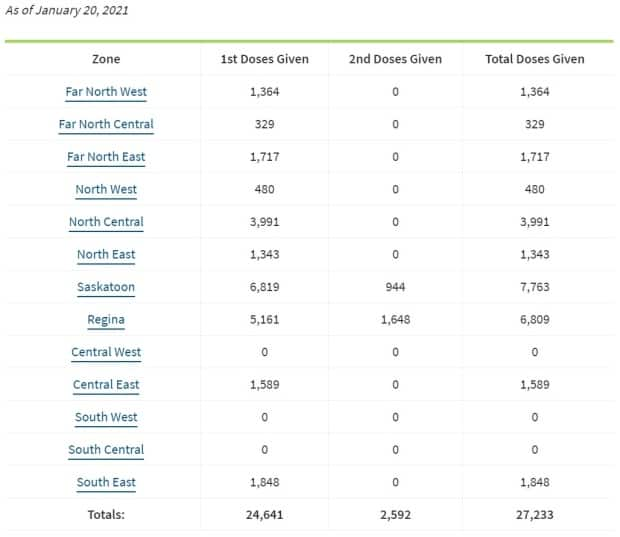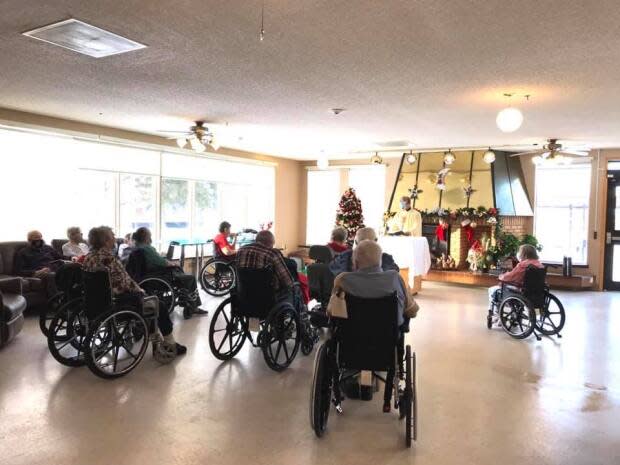5 things to know about Sask.'s Phase 1 vaccine plan — including who decides where early doses go
It's been just over a month since the Saskatchewan government delivered its first doses of COVID-19 vaccine, starting with health-care workers in Regina.
Over 27,000 first and second doses have since been administered to people in priority groups in 10 of the regions monitored by health officials, under the first phase of the province's vaccine rollout plan.
However, no vaccinations had been done as of Wednesday in the south central region — which includes Moose Jaw, the fourth-largest city in the province — the central west, or the southwest, to the puzzlement of some.
How is the Saskatchewan government making decisions on Phase 1 of the vaccine rollout — and exactly who is making those decisions?
Here's what we know.
The daily COVID updates provide some idea of the delivery schedule
Bookmark this page, which is home to the COVID-19 updates provided each day by provincial health officials. The updates are typically released at around 1:30 p.m. CST.
Recently, at the top of each release, the day's new cases have taken a back seat to updates about the vaccination rollout, including where doses will be sent.
On Tuesday, for example, officials revealed that the week's shipment of 2,925 Pfizer-BioNTech vaccine doses would be divided between the Regina, Fort Qu'Appelle and North Battleford areas, and would be used to continue vaccinating priority populations — health-care workers, people living in northern or remote parts of Saskatchewan, seniors, and long-term care home residents.
No specific locations within those communities were disclosed, however.
"We have a great deal of confusion when it comes to who is on the list, who's in Phase 1," said Saskatchewan NDP Leader Ryan Meili.
The complete tally of doses administered in the 13 regions is updated daily on this page.
Here's how things looked as of Wednesday:

Transmission rates, active case loads and outbreaks are key factors
The limited availability of vaccines and the logistics of handling the Pfizer-BioNTech vaccine — which needs to be refrigerated at extremely low temperatures — play a role in determining where the vaccines will go, said Scott Livingstone, the CEO of the Saskatchewan Health Authority.
But so do transmission rates in an area, he added.
"One of the other big factors in the distribution is the attack rates, or the current caseload in those areas of the province which also have a high likelihood for us to be successful in … dealing with the most vulnerable," Livingstone said.
The Ministry of Health added that locations are prioritized based on "a combination of risk criteria," including an area's outbreak rate.
Moose Jaw is located in what the province calls the South Central 2 subzone. As of Wednesday, the subzone, with a population of 43,862, had only 22 active COVID-19 cases. By comparison, the neighbouring Regina and area subzone, with a population of 273,287, reported 575 active cases.
Moose Jaw had only three active outbreaks. Regina had dozens.
CBC News has asked the ministry what other risk criteria determine where Phase 1 vaccines will go.
4 regional command centres choose where to send vaccines
The decisions of two key groups determine where vaccines will go, according to the ministry.
"While priority sequencing is determined by the COVID-19 Immunization Planning Oversight Committee, specific locations and facilities are determined by local Integrated Health Incident Command Centres (IHICCs)."
These groups are represented on the oversight committee:
Ministry of Health.
Ministry of Government Relations.
Saskatchewan Public Safety Agency.
Indigenous Services Canada.
Saskatchewan Health Authority.
The committee oversees a number of subcommittees, including the COVID-19 Immunization Planning Indigenous Advisory Committee, the COVID-19 Immunization Planning Municipal Advisory Committee and the COVID-19 Immunization Planning Clinical Experts Advisory Committee.
These committees "help inform the development of the COVID-19 immunization program in the province," according to the ministry.
CBC News has requested a list of the organizations represented on each committee.
The regional command centres that decide on specific vaccine shipment locations date back to the early days of the pandemic. There are four of them: Saskatoon, Regina, rural and north, run according to "a military command and control-based reporting structure," according to the Saskatchewan Health Authority.
The integrated command centres "must operationalize the sequencing framework created by the oversite committee and determine their clinics," according to the ministry.
"Vaccine chiefs" and "vaccine physician co-leads" work with the command centres to review delivery locations, the ministry says.
CBC News has asked who is in charge of each command centre and where the vaccine chiefs rank in the pecking order.
Vaccines are going to care homes with outbreaks. Some COVID-positive residents are among those getting doses
Two facilities run by private home care operator Extendicare have had residents and staff receive COVID-19 vaccines: the Parkside home in Regina, which was the site of the worst long-term care outbreak in the province, and the Preston home in Saskatoon.
"Fifty-two of 53 eligible [Preston] residents" were vaccinated as of last Friday, even as other residents were infected, according to Extendicare.
All residents vaccinated at Parkside and Preston were either COVID-free at the time or had never tested positive for the virus that causes the illness, according to Extendicare — which is in line with a policy espoused by the Ministry of Health.
"You are noteligible to receive COVID vaccine at this time if you have been diagnosed with COVID in the last 90 days," the ministry recently said in a public service announcement touting the availability of vaccines for seniors living independently.
But at least one care home in the province has seen COVID-positive residents vaccinated in recent days.
Lakeview Pioneer Lodge, a private care home in Wakaw, Sask., had 28 COVID-positive residents vaccinated on Jan. 15, said Michael Lummerding, the home's administrator and CEO. The home has been dealing with an outbreak since Dec. 30.
"All residents were given the option to be vaccinated as per the medical health officer," Lummerding said. "Staff members were given the opportunity to be vaccinated to ensure all doses were utilized and none were wasted."
Seventeen staff were vaccinated, along with two workers declining, he added.

The vaccination of COVID-19 positive residents at Lakeview occurred three days after a letter saying the Standing Committee on Immunization approved of vaccinating long-term care residents infected with COVID-19.
The letter was sent by Saskatchewan Chief Medical Health Officer Dr. Saqib Shahab to medical health officers, public health nurse managers and immunization providers.
"Residents of long-term care facilities and personal care homes, and persons aged 80 years and older living in the community, should be immunized, irrespective of whether and when they had SARS-CoV-2 infection," as long as they had recovered from the acute illness and there were no other factors to prevent it, the letter said.
"[T]hey are extremely vulnerable and there is no clear evidence on the length of disease immunity among these populations," the letter stated.
Cory Neudorf, a professor of community health and epidemiology at the University of Saskatchewan, said that may refer to people who are no longer infectious but may still test COVID-positive.
He said the move makes sense.
"It is still unclear how long immunity from natural infection lasts, and there is some evidence of people who have been infected twice, though still rare at this point," Neudorf said.
"In order to speed up delivery of the vaccine and ensure people are not missed later on, it makes sense to try to immunize everyone in a long-term care facility regardless of whether they have had prior infection."
The National Advisory Committee on Immunization — from which the province took its cues in choosing priority groups for Phase 1 — made a discretionary recommendation earlier this month stating that if vaccines are in short supply, initial does may be prioritized for those who have not been infected with COVID-19.
"In the context of limited supply, to allow for the protection of a larger number of at-risk individuals, vaccination with a COVID-19 vaccine may be delayed for three months [for someone infected with COVID-19], as reinfections reported to date have been rare within the first three months following infection," the committee wrote on Jan. 12.
"However, if challenging from a feasibility perspective, jurisdictions may elect to disregard prior infection status and vaccinate everyone in a given target group."
Visitations won't resume just because care home residents are getting vaccinated
Visitors have been strictly banned at all long-term care homes in the province for months now, with exceptions allowed only for those visiting dying patients.
On Tuesday, Dr. Saqib Shahab, Saskatchewan's chief medical health officer, was asked if those restrictions might be relaxed in homes where people are being vaccinated.
Shahab said that while clinical vaccine trials have shown 95 per cent effectiveness, the vaccine may not be that effective for everybody, leaving some residents still susceptible to COVID-19.
"Once we have the vast majority of the population vaccinated — especially adults with underlying risk factors, but also broadly all adults — I think then we can cautiously start looking at how we relax our public health measures over the summer," he said.

